Tamron SP 70-200mm F/2.8 Di VC USD Review

Introduction
The Tamron SP 70-200mm F/2.8 Di VC USD is a fast telephoto zoom lens for Canon, Sony and Nikon full-frame DSLR cameras. This compact lens features a constant aperture of f/2.8 throughout the range, Vibration Compensation (VC) technology, and an ultrasonic focus motor for quiet AF operation, and a moisture-sealed construction. The optical formula comprises 23 lens elements in 17 groups, including one XLD (Extra Low Dispersion) glass and four LD (Low Dispersion) elements, and an iris diaphragm with nine rounded aperture blades. The Tamron SP 70-200mm F/2.8 Di VC USD lens officially retails for £1,399.99 / $1499.
Ease of Use
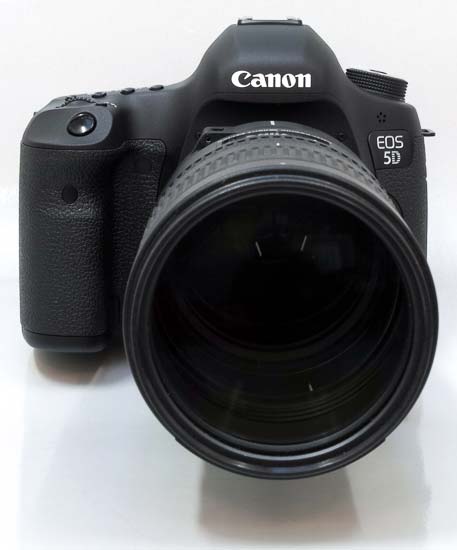 The Tamron SP 70-200mm F/2.8 Di VC USD lens mounted on a Canon EOS 5D Mk III
The Tamron SP 70-200mm F/2.8 Di VC USD lens mounted on a Canon EOS 5D Mk III
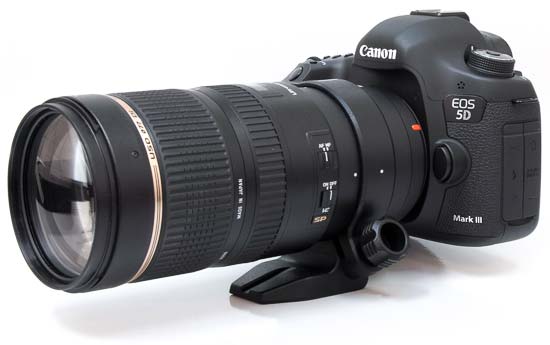 The Tamron SP 70-200mm F/2.8 Di VC USD lens, isometric view
The Tamron SP 70-200mm F/2.8 Di VC USD lens, isometric view
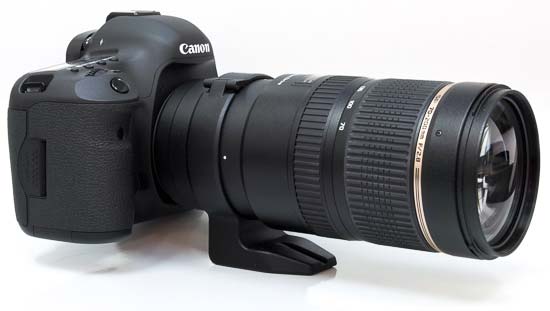 The Tamron SP 70-200mm F/2.8 Di VC USD lens, isometric view
The Tamron SP 70-200mm F/2.8 Di VC USD lens, isometric view
For such a fast telephoto zoom lens, the Tamron SP 70-200mm F/2.8 Di VC USD is predictably quite big and bulky, measuring almost 20cms in length and wighing in at just under 1.5Kg with the detachable tripod mount attached. While you can use it on a smaller APS-C body, it won't balance very well (and the focal length will also change) - as demonstrated by the images above, it's a much better match for a professional-grade, full-frame camera like the 5D Mark III, where it feels better balanced.
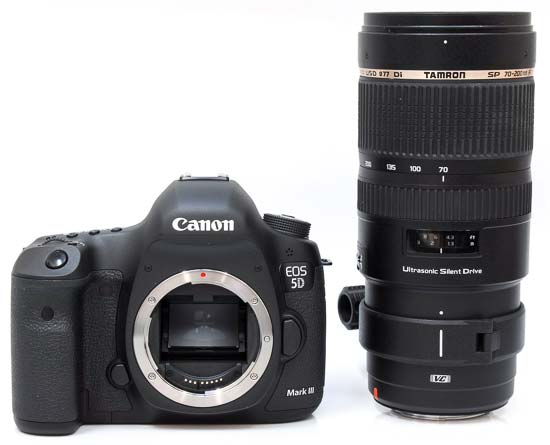 The Tamron SP 70-200mm F/2.8 Di VC USD lens alongside the Canon EOS 5D Mark III
The Tamron SP 70-200mm F/2.8 Di VC USD lens alongside the Canon EOS 5D Mark III
Build quality is very good, despite Tamron traditionally offering lenses at the cheaper end of the market. The more premium-priced Tamron SP 70-200mm F/2.8 Di VC USD feels solid in your hand, even if the outer barrel and the filter thread appear to be made from plastic.
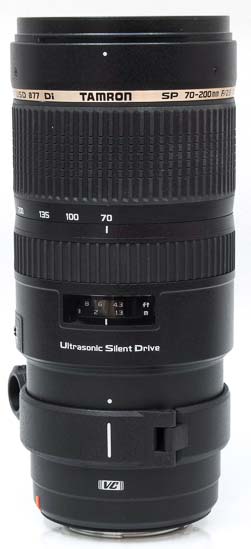 Front of the Tamron SP 70-200mm F/2.8 Di VC USD lens
Front of the Tamron SP 70-200mm F/2.8 Di VC USD lens
 Front of the Tamron SP 70-200mm F/2.8 Di VC USD lens
Front of the Tamron SP 70-200mm F/2.8 Di VC USD lens
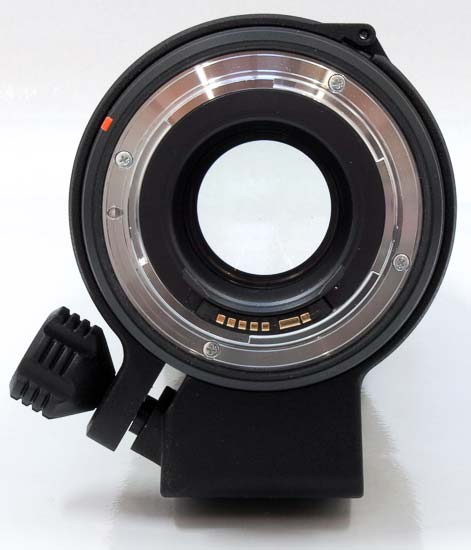 Rear of the Tamron SP 70-200mm F/2.8 Di VC USD lens
Rear of the Tamron SP 70-200mm F/2.8 Di VC USD lens
The zoom ring is generously wide and has a ridged, rubberised grip band. The lens doesn't extend at any point when you zoom out from 70mm and the filter ring doesn't rotate, good news for filter users.
The focusing ring is much narrower, making it difficult to locate in a rush, but it is well damped. There's a distance scale that runs from the closest distance of 1.3m to infinity, but no depth of field scale. An AF/MF switch on the side of the lens makes it easy to switch between the two focusing systems.
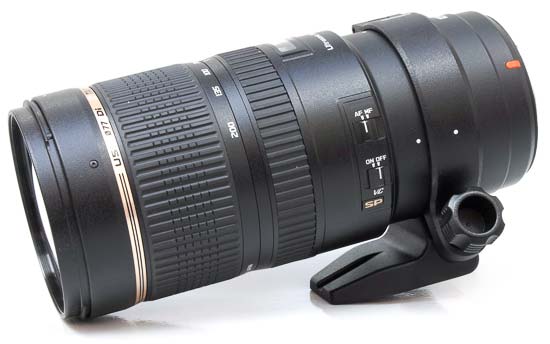 Side of the Tamron SP 70-200mm F/2.8 Di VC USD lens
Side of the Tamron SP 70-200mm F/2.8 Di VC USD lens
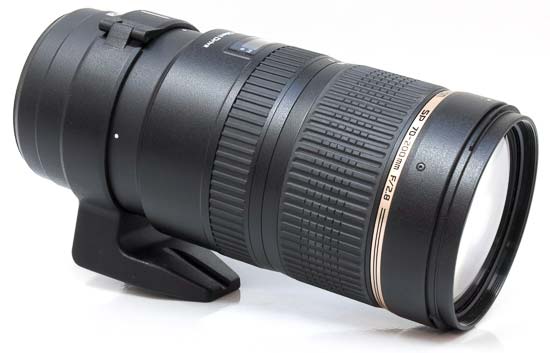 Side of the Tamron SP 70-200mm F/2.8 Di VC USD lens
Side of the Tamron SP 70-200mm F/2.8 Di VC USD lens
 The Tamron SP 70-200mm F/2.8 Di VC USD lens in-hand
The Tamron SP 70-200mm F/2.8 Di VC USD lens in-hand
The final control is the VC On / Off switch, which turns the lens' built-in Vibration Compensation on and off. This is a big selling point for the Tamron SP 70-200mm F/2.8 Di VC USD. In practice we found it offered around 3 f-stops of compensation, obviously dependant upon your own particular hand-holding technique, making it easier to use the lens in low-light.
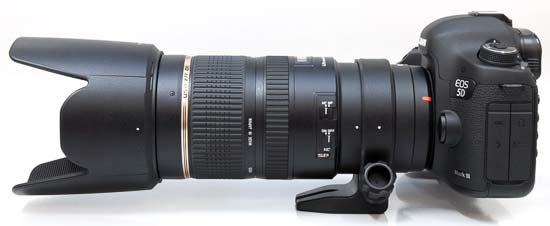 The Tamron SP 70-200mm F/2.8 Di VC USD lens fitted with the lens hood and the detachable tripod mount
The Tamron SP 70-200mm F/2.8 Di VC USD lens fitted with the lens hood and the detachable tripod mount
The lens is supplied with lens caps and a large flower-shaped lens hood - there's no bag included. The filter size is 77mm.
Auto-focus
The Tamron SP 70-200mm F/2.8 Di VC USD features a USD (Ultrasonic Silent Drive) that allows near-silent auto-focusing. Importantly, this solution allows instant manual override even when the focus mode switch is in the AF position. Focusing is fully internal, meaning the length of the lens always remains constant. In use, we found the focusing to be indeed very quiet, and pretty fast - but definitely not instantaneous - with the lens mounted to a Canon EOS 5D Mk III body.
Chromatic Aberrations
Chromatic aberrations, typically seen as purple or blue fringes along contrasty edges, are impressively well controlled with this lens - the examples below show the worst-case scenario.
 |
 |
Focal Range
The Tamron SP 70-200mm F/2.8 Di VC USD offers a classic focal range for full-frame DSLR owners.
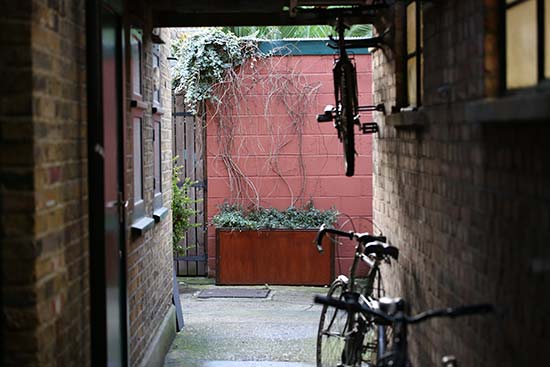 70mm
70mm
 200mm
200mm
Light Fall-off
With the Tamron SP 70-200mm F/2.8 Di VC USD wide open at f/2.8, you can see some very noticeable light fall-off in the corners at both ends of the zoom range. Stopping down helps, although to completely get rid of this phenomenon, you will need to use an f-stop of f/5.6 or smaller.


Macro
The Tamron SP 70-200mm F/2.8 Di VC USD is not a macro lens. The close-focus point is at 1.3m from the film/sensor plane. The following example illustrates how close you can get to the subject with the lens set to 200mm to aid magnification, in this case a CompactFlash card.
 Close-up performance
Close-up performance
Bokeh Examples
Bokeh is a word used for the out-of-focus areas of a photograph, and is usually described in qualitative terms, such as smooth / creamy / harsh etc. One of the reason to buy a fast lens is to be able to isolate the subject from the background, which is normally very hard to do with an ultrawide lens. Tamron was apparently very much aware of this requirement, as they employed an iris diaphragm with 9 rounded blades for a pleasing rendering of the out-of-focus highlights. Based on what we have seen, we can say that they largely succeeded. Below you'll find some examples, but you are also encouraged to check out our sample images.
 |
 |
 |
 |
Sharpness
In order to show you how sharp this lens is, we are providing 100% crops on the following pages.
